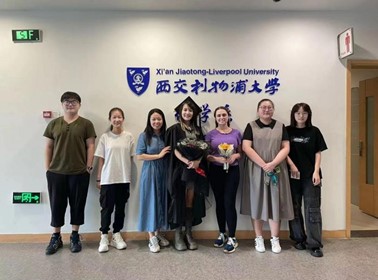09 Apr 2024
Recently, Dr. Meng Ding of the School of Science and undergraduate students of the Department of Chemistry of Xi'an Jiaotong-Liverpool University jointly participated in the projects “Unveiling the sodium adsorption behavior of controlled NaTi2(PO4)3 on Ti3C2Tx MXene for balanced salt adsorption capacity and cycling stability” and “A ‘two-birds-one-stone’ strategy to enhance capacitive deionization performance of flexible Ti3C2Tx MXene film electrodes by surface modification”. These two projects were published in the journals Separation and Purification Technology and Journal of Materials Chemistry A, respectively. The reported modified MXene electrodes improve the adsorption capacity and long-term stability via structure design and functional modification unblocking the technical bottleneck of MXene in capacitive deionization application.
Unveiling the sodium adsorption behavior of controlled NaTi2(PO4)3 on Ti3C2Tx MXene for balanced salt adsorption capacity and cycling stability - Undergraduate student Tianqin Huang

Capacitive deionization (CDI) technology is an efficient and environmentally friendly electrochemical desalination method. Tianqin Huang explained, “CDI uses an applied electric field to adsorb ions in water to the electrode surface, thus achieving the purpose of desalting. Its low energy consumption, high efficiency and easy regeneration have made it an attractive option for desalination and water treatment.”
In this study, the research team proposed an innovative design scheme: in-situ growth of NaTi2(PO4)3 (NTP) nanoparticles on Ti3C2Tx MXene, and the use of polyvinylpyrrolidone as a structural stabilizer to optimize reaction kinetics and structural stability. The NTP@MXene electrode with unique nanocube structure of NTP grown on the surface of MXene through Ti-O bonding between NTP and MXene, significantly improves the stability and CDI performance .
After detailed electrochemical testing and kinetic analysis, the research team found that under the optimal condition of 50% ratio of NTP to MXene, NTP@MXene electrode showed excellent desalination capacity, reaching 171.43 mg g-1, and ion adsorption rate up to 4.37 mg g-1 min-1. After 100 cycles, the capacity retention rate remained at 85%, showing a good cycle performance.
Tianqin Huang said that the development of NTP@MXene CDI electrode material has set a new milestone for improving seawater desalination capacity and adsorption rate. Its superior performance in seawater desalination capacity, ion adsorption rate and cycle stability opens up a new way to improve the efficiency and effectiveness of CDI technology. The innovative design and insights from this study will also stimulate further exploration for electrochemical desalination and advance the development of sustainable water treatment methods.
“For the public, the successful development of advanced CDI technology not only provides new possibilities to address global water scarcity, but also provides strong support for the advancement of sustainable water management.” Tianqin Huang said.

A “two-birds-one-stone” strategy to enhance capacitive deionization performance of flexible Ti3C2Tx MXene film electrodes by surface modification - PhD student Chuhan Huang
 Surface modification is another important method to prepare high performance capacitive deionization electrode. Through surface modification, surface properties, structure and chemical composition can be tuned to improve its performance at the interface, or improve its adsorption capacity for specific substances, introduce new functional components, improve the mechanical properties and durability of the material, and so on. Surface modification can also enhance the mechanical robustness, oxidation resistance and corrosion resistance of the material, making it more suitable for various environments of practical applications.
Surface modification is another important method to prepare high performance capacitive deionization electrode. Through surface modification, surface properties, structure and chemical composition can be tuned to improve its performance at the interface, or improve its adsorption capacity for specific substances, introduce new functional components, improve the mechanical properties and durability of the material, and so on. Surface modification can also enhance the mechanical robustness, oxidation resistance and corrosion resistance of the material, making it more suitable for various environments of practical applications.
In her undergraduate final year project, Chuhan Huang focused on MXene surface modification, and proposed a new approach of MXene surface modification by using sodium ascorbate (SA) to obtain flexible free-standing MXene electrode material, which significantly improved the performance of CDI electrodes. The ascorbate ions in SA can effectively bond to the oxygen-containing functional groups on the surface of MXene to protect it from oxidation, while the insertion of sodium ions expands the layer spacing of MXene. This innovative strategy not only enhances the oxidation resistance and the cycling stability of CDI, but also significantly improves the salt adsorption capacity and salt adsorption rate of MXene. At the same time, compared with conventional MXene composite preparation methods (such as hydrothermal method, ball milling method, high-temperature annealing method), the method can be carried out at room temperature, which is conducive to the large-scale preparation of anti-oxidation MXene composite materials.
The team found that the modified SA-MXene has promising desalination performance. The salt adsorption capacity reached 109.6 mg g-1, the salt adsorption rate reached 17.5 mg g-1 min-1, and the capacity retention rate remained at 100% after 80 cycles, showing excellent cyclic stability. The flexible free-standing structure further expands the application field and can adapt to various complex shapes and application scenarios. This research result provides a new possibility for the development of CDI electrode materials and is expected to promote the further application of capacitive deionization technology. At present, Chuhan Huang is continuing her doctoral studies at Xi'an Jiaotong-Liverpool University to further explore the great potential of MXene complex in the field of seawater desalination.
Dr. Meng Ding, the principal investigator of the project, said: “we are very proud of the research results, which are not only an affirmation of the efforts of our research team, but also inspire the development of capacitive deionization technology. We expect that this achievement can be widely applied in the future, and provide new solutions to alleviate the strain of global water shortage. In addition, through research projects such as summer undergraduate research fellowship (SURF) or final year projects, our undergraduates have improved their scientific research ability and comprehensive capability, and learned collaboration skills , which is conducive to their future academic research or career development.”
 Figure 1. The combination of sodium ascorbate and MXene
Figure 1. The combination of sodium ascorbate and MXene
 Figure 2. Shows the changes of MXenes, 8-SA-MXene, 12-SA-MXene, and 16-SA-MXene over time. This reflects the ion adsorption properties of the material.
Figure 2. Shows the changes of MXenes, 8-SA-MXene, 12-SA-MXene, and 16-SA-MXene over time. This reflects the ion adsorption properties of the material.
Article link:
https://www.sciencedirect.com/science/article/pii/S1383586624003526
https://pubs.rsc.org/en/content/articlehtml/2024/ta/d4ta00236a
09 Apr 2024







